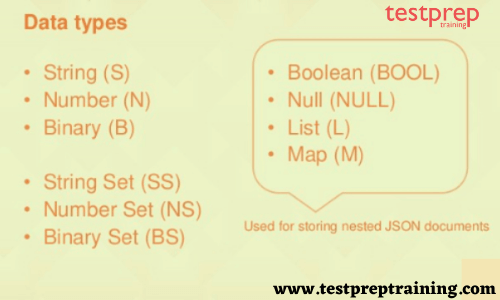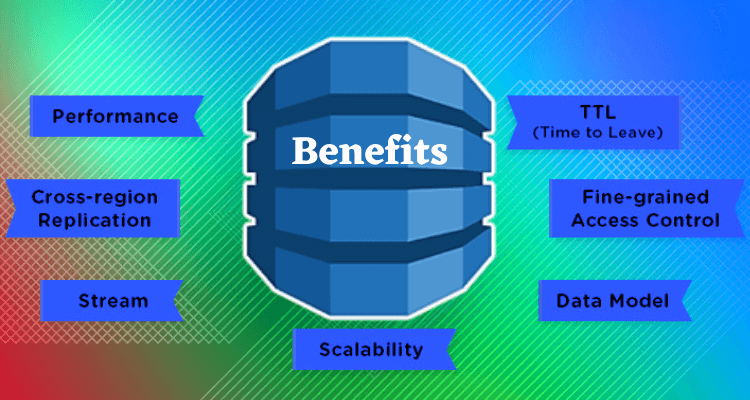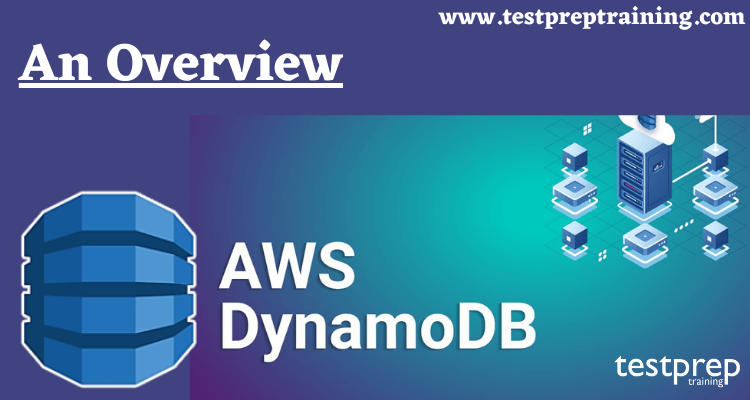Amazon DynamoDB is a key-value, NoSQL database generated by Amazon. It is a key-value and document database that gives single-digit millisecond administration at any scale. Also, it is a completely managed, multi-active, multi-region, durable database with finished-in security, backup and restores, and in-memory accumulating for internet-scale applications. Further, we can say that DynamoDB can manage more than 10 trillion requests every day and can hold peaks of more than 20 million requests every second.
Many fastest-growing businesses such as Airbnb, Lyft, and Redfin as well as enterprises like Toyota, Samsung, and Capital One depend on the performance and scale of the DynamoDB to maintain their mission-critical workloads. Thousands of AWS consumers have preferred DynamoDB as their document database and key-value for web, mobile, IoT, ad tech, gaming, and other applications that require deep-latency data access at any order.
Considering the high availability and durability, DynamoDB automatically separates the traffic and data for the tables across a satisfactory quantity of servers to manage the throughput and storage necessities, while sustaining constant and quick performance. All of the data is saved on (SSDs) solid-state disks and is replicated across various Availability Zones in an AWS Region automatically, giving built-in high availability and data persistence. Further, we can handle global tables to manage DynamoDB tables in sync beyond AWS Regions.
Data Types:
DynamoDB maintains the following mentioned data types:

- Scalar – String, Number, Boolean, Binary, and Null.
- Document – Map and List.
- Multi-valued – Number Set, String Set, and Binary Set.
Scalar kinds are commonly well known. We’ll focus alternately on multi-valued and document standards. Multi-valued prototypes are sets, which implies that the prices in this data type are unprecedented. For a month’s associate, you can pick a String Set with the titles of all twelve months – each of which is, of course, unprecedented.
Benefits of Amazon DynamoDB
It’s time to mention some advantages of the Amazon DynamoDB.
1. Performance at scale
DynamoDB preserves many of the world’s most extensive scale applications by producing constant, single-digit millisecond answer times at any scale. One can develop applications with practically limitless storage and throughput. DynamoDB global tables replicate the data beyond multiple AWS Regions to provide fast, limited access to data for globally distributed applications. In addition, DynamoDB Accelerator gives a completely managed in-memory cache for application cases that need faster access with microsecond latency.
2. No servers to manage
Amazon DynamoDB is serverless including no servers to provision, patch, or maintain and no software to maintain, install or work. DynamoDB automatically estimates tables up and down to accommodate for capacity and manage performance. Availability and fault threshold is built-in, reducing the requirement to architect the applications for these abilities. DynamoDB gives both provisioned and on-demand capability modes so that one can optimize prices by stipulating capacity per workload or funding for only the sources they consume.
3. Enterprise ready
DynamoDB upholds ACID transactions to allow us to strengthen business-critical applications at order. DynamoDB encrypts all information by default and gives fine-grained integrity and access control on all the tables. We can perform full backups of numbers of terabytes of data directly with no performance impression to the tables, and obtain to any point inexperience in the preceding 35 days with no downtime. We also can transport the DynamoDB table data to the data lake in Amazon S3 to implement analytics at any scale. Also, DynamoDB is strengthened by a service level agreement for assured availability.

How does DynamoDB work?
Amazon DynamoDB looks like JSON, with the one variation being that each JSON record should incorporate the record key. That has the benefit that it lets one perform updates on a record. In a JSON database, such as MongoDB, we cannot modernize records. Rather, we must remove them then supplement back the modified version to transform the same change.
DynamoDB also lets us operate with transactions, something that MongoDB maintains as well. Not all NoSQL databases let us do that. This is necessary as some database operations inevitably should go together. For instance, a sales transaction should both decrement inventory and improve cash on hand. If one of those 2 operations displeased then the sales and inventory operations would be out of scale.
Usually, we work with databases utilizing the AWS command-line client, APIs for various programming dialects, their NoSQL workbench desktop device, or on the AWS website.
Generally, Amazon DynamoDB has the following concepts:
- Table: a selection of items.
- Item: a compilation of attributes.
- Stream: It is like a cache that endures alterations in memory until they are flooded to storage.
- Partition key: the initial key. It must be unusual.
- Partition and sort key: a composite initial key, suggesting a partition key with more further than 1 attribute, like employee ID and employee name ( important because 2 employees could have the identical name).
- Secondary indexes: we can arrange other attributes that we usually query to speed up reads.
API and SDK:
As with most utmost cloud systems, DynamoDB unveils its services through web services. But that does not imply one has to format the data to JSON and then post it utilizing HTTP. Instead, they give (SDKs) software development kits. The SDK practices the requests we send and then transposes that to HTTP calls backward the scenes. In this system, the SDK gives a straightforward and far less wordy approach to practice with the database. The SDK lets us work with DynamoDB as we would work with conventional objects.
The SDK has the following methods:
- PutItem
- Scan
- GetRecords
- GetItem
- ListStreams
- TransactWriteItems
- BatchGetItem
- DeleteItem
- GetShardIterator
- BatchWriteItem
- Query
- UpdateItem
- TransactGetItems
Use cases of Amazon DynamoDB
Now, we are going to discuss the use cases of the DynamoDB. Let us start:
1. Ad Tech
Organizations in the (ad tech) advertising technology vertical practice DynamoDB as a fundamental-value reserve for collecting different kinds of marketing data, like user events, clicks, user profiles, and toured links. Applicable use cases involve ad targeting, real-time bidding (RTB), and attribution. These cases need a great request rate (millions of requests per second), low expected latency, and security. Further, companies practice caching by (DAX) DynamoDB Accelerator when they have great read volumes or require submillisecond read latency. Frequently, ad tech organizations require to expand their RTB and ad targeting programs in more than 1 geographical AWS Region, which needs data replication among Regions.
2. Gaming
Corporations in the gaming upright use DynamoDB in all abilities of game platforms, involving player data, session history, game state, and leaderboards. The principal benefits that these corporations receive from DynamoDB are its capability to estimate certainly to millions of concurrent users and requests while guaranteeing consistently less latency estimated in single-digit milliseconds. In extension, as a fully managed, DynamoDB has no operational expenses, so game developers can concentrate on progressing their games rather than accomplishing databases. Further, as game developers are frequently looking to increase from an individual AWS Region to various AWS Regions, they can rely on the DynamoDB global tables for multiple-Region, active replication of data.
General-use cases:
- Player data stores
- Game states
- Player session history data stores
- Leaderboards
3. Banking and Finance
As businesses in banking and finance constitute more cloud-native applicability, they attempt to practice fully managed assistance to improve agility, decrease time to market, and depreciate operational overhead. At the very same time, they have to guarantee the reliability, security, and great availability of their applications. As these corporations extend their current services that are supported by legacy mainframe systems, they perceive that legacy systems are inadequate to satisfy the scalability requirements of their expanding user base, new programs like mobile applications, and the resulting increments in traffic. To resolve this problem, they replicate the data from their mainframes to the cloud to offload the traffic.
Common use cases include:
- Event-driven transaction processing
- User transactions
- Scam detection
- Mainframe offloading and modify data capture
4. Media and entertainment
Media and entertainment organizations practice DynamoDB when they need an absolute scale of concurrency and throughput, lowering latency, and authenticity. DynamoDB computations elastically to manage the load and sustains low latency that is important for real-time situations, such as interactive content and video streaming. In such situations, the quantity of concurrent users can relinquish millions, and no database manages that sort of concurrency, also DynamoDB. Notwithstanding such high concurrency, the latency persists low, allowing individual users optimal user encounter, whether it includes recovering their media, or cooperating in an interactive, real-time event. These corporations practice DynamoDB to discuss their scalability difficulties and to maintain their focus on the feature construction and not on database management.
General use cases:
- User data stores
- Digital rights management data stores
- Media metadata stores
5. Software and Internet
One key commonality amongst software corporations and many different DynamoDB consumers is internet scale. These organizations’ practice cases need the capability to support advanced request rates, concurrency, and spikes in the traffic. This concurrency is estimated in millions of users and associates, and request rates can quickly reach millions every second. DynamoDB has a demonstrated record of being capable to manage internet-scale use cases and their conditions while sustaining steady, single-digit millisecond latency. Further, with the global tables, DynamoDB consumers can efficiently develop their applications to various AWS Regions for global influence and business succession.
Common use cases:
- Metadata caches
- User content metadata reserves
- User vocabulary data stores
- Ride-tracking data stores
- Correlation graph data stores
- Vehicle, and driver data stores
Is it possible to download DynamoDB?
Yes, we can further download DynamoDB and stream it on the local system. Their web site does not specify whether it is free, indicating whether we could utilize it forever and nevermore pay. The idea is we practice it to test code regionally, and thus preserve money, before assigning it to the cloud.
We can, for instance, add it as a Maven dependency in the Java project. That indicates when we run the Java code in the code editor it will download the DynamoDB and shape up an instance for us with small to no configuration needed.
Summarizing:
There are several well-known NoSQL databases accessible, consisting Cassandra, HBase, Amazon DynamoDB, MongoDB, Redis, and Riak. Each of these was produced for a particular range of uses and will consequently offer various features. Like other AWS product, Amazon DynamoDB was created for the failure (i.e., it has resilience established in and self-recovery). That makes DynamoDB an extremely scalable, available, and classified data store. We at Testpreptraining hope that this article helped you! Stay safe and keep practicing!


